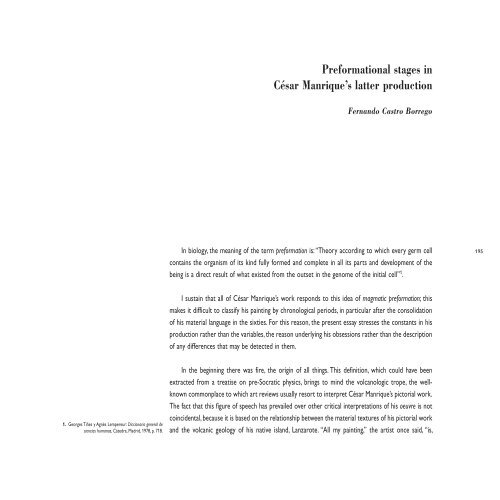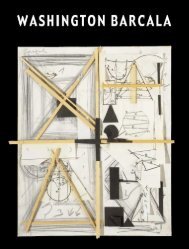VERSIÓN INGLESA ENGLISH VERSION - Fundación César Manrique
VERSIÓN INGLESA ENGLISH VERSION - Fundación César Manrique
VERSIÓN INGLESA ENGLISH VERSION - Fundación César Manrique
Create successful ePaper yourself
Turn your PDF publications into a flip-book with our unique Google optimized e-Paper software.
1. Georges Tiñes y Agnès Lempereur: Diccionario general de<br />
ciencias humanas, Cátedra, Madrid, 1978, p. 718.<br />
Preformational stages in<br />
<strong>César</strong> <strong>Manrique</strong>’s latter production<br />
Fernando Castro Borrego<br />
In biology, the meaning of the term preformation is: “Theory according to which every germ cell<br />
contains the organism of its kind fully formed and complete in all its parts and development of the<br />
being is a direct result of what existed from the outset in the genome of the initial cell” 1 .<br />
I sustain that all of <strong>César</strong> <strong>Manrique</strong>’s work responds to this idea of magmatic preformation; this<br />
makes it difficult to classify his painting by chronological periods, in particular after the consolidation<br />
of his material language in the sixties. For this reason, the present essay stresses the constants in his<br />
production rather than the variables, the reason underlying his obsessions rather than the description<br />
of any differences that may be detected in them.<br />
In the beginning there was fire, the origin of all things. This definition, which could have been<br />
extracted from a treatise on pre-Socratic physics, brings to mind the volcanologic trope, the wellknown<br />
commonplace to which art reviews usually resort to interpret <strong>César</strong> <strong>Manrique</strong>’s pictorial work.<br />
The fact that this figure of speech has prevailed over other critical interpretations of his oeuvre is not<br />
coincidental, because it is based on the relationship between the material textures of his pictorial work<br />
and the volcanic geology of his native island, Lanzarote. “All my painting,” the artist once said, “is,<br />
195
















![Becas y premios de la Fundación César Manrique [1997-2006]](https://img.yumpu.com/20766851/1/184x260/becas-y-premios-de-la-fundacion-cesar-manrique-1997-2006.jpg?quality=85)
